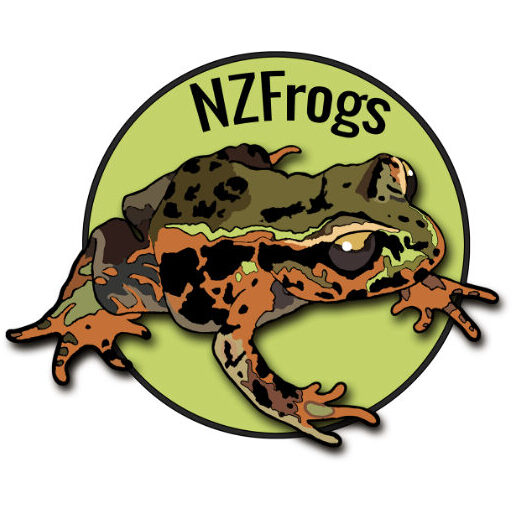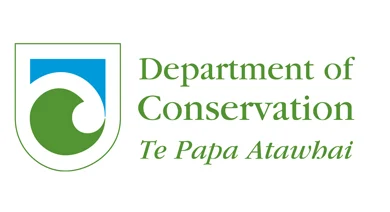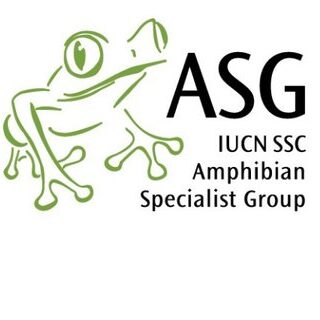Key issues in New Zealand
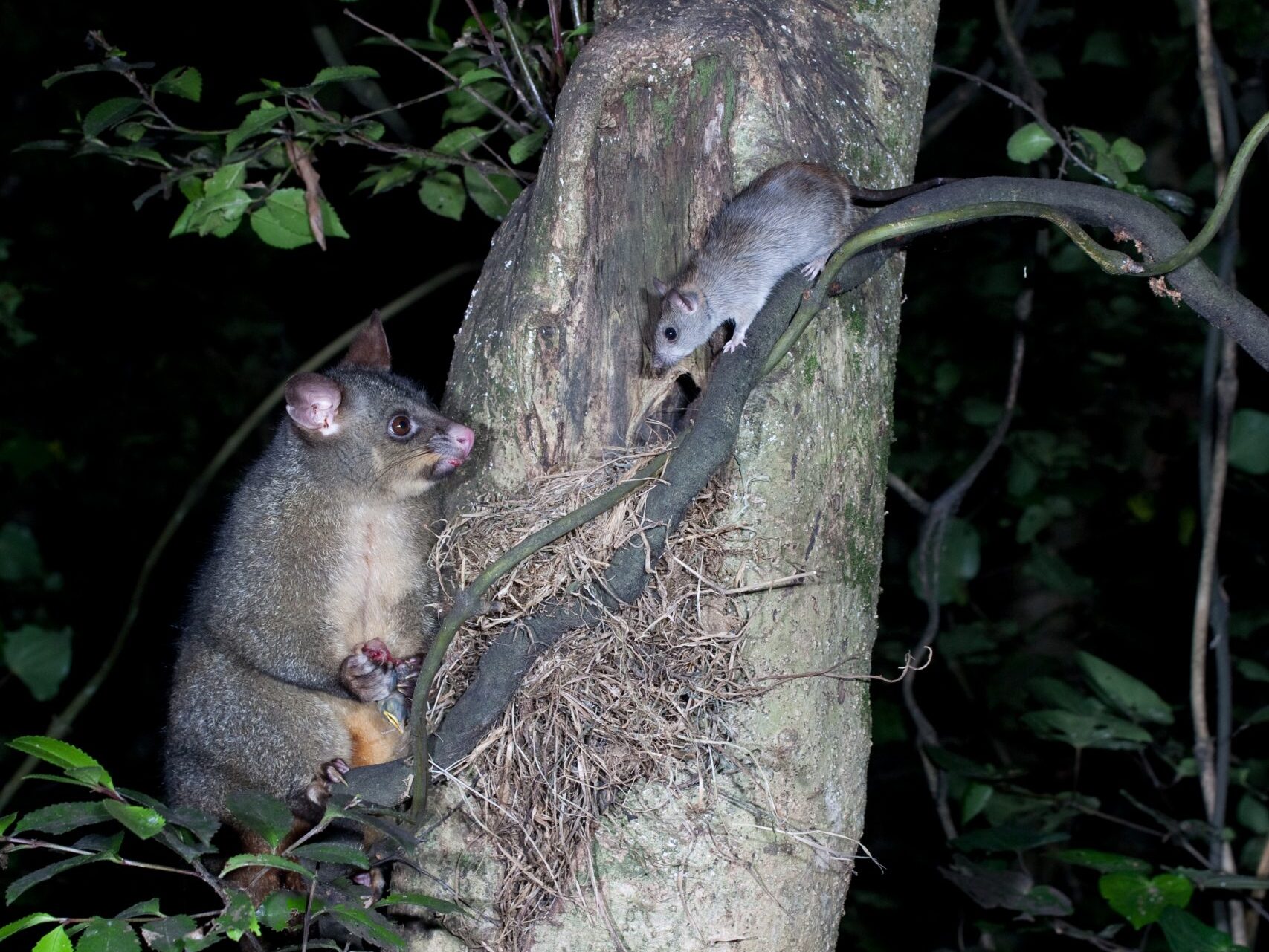
Image by Ngā Manu
Mammalian Predators
Evidence suggests predation and/or competition with non-native mammals, especially rats and pigs, may be key drivers responsible for native frog declines. The kiore (Rattus exulans) likely caused an initial decline in native frog populations and the extinction of three species before European arrival in New Zealand. Further introductions of non-native mammals have continued the decline in native frog populations. Now, Hamilton’s frog only survives naturally on mammal-free island refugees. It is somewhat difficult to evaluate the exact nature of the effect of non-native mammals on native frogs. Ship rats (Rattus rattus) and feral pigs (Sus domesticus) have been documented predating upon Hochstetter’s and Archey’s frogs in North Island forests. It’s also possible mice may prey on juvenile frogs but further research is needed.
Habitat Change
Historical declines may also be partially attributed to the destruction of forest habitats that followed the arrival of Polynesian and European settlers. As amphibians, Leiopelma frogs have very specific habitat requirements preferring pristine native ecosystems. In particular, Hochstetter’s frog continues to be threatened by localised destruction of stream habitat that occurs as a result of mining, forestry and farming practices. Non-native mammals such as pigs and goats can cause severe disturbance and degradation of habitat which may also affect native frogs.

Image by ©Kimball Chen
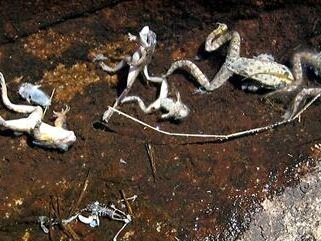
Image by ©CISR
Disease
Chytrid fungus (Batrachochytrium dendrobatidis) has been implicated in the worldwide decline of numerous amphibian species. Frogs infected with this fungus suffer chytridiomycosis, a disease that affects their skin and is often fatal. Chytrid zoospores can survive in damp conditions. They may be transported between frog populations in muddy clothing, footwear or by the pet trade. However, it has never been detected in Hochstetter’s frog. It is assumed infection caused one population of Archey’s frog in the Coromandel Peninsula to decline in numbers by over 80%. Subsequent experimental infection of both Archey’s and Hamilton’s frogs showed these frogs produce antimicrobial peptides which inhibit chytrid growth; frogs did not show clinical symptoms. Because Leiopelma frogs seem to have a low susceptibility to chytrid fungus, it might not be as important of a conservation concern as it is for frogs globally.
Conservation action in New Zealand
Department of Conservation and Native Frog Recovery Group
The Native Frog Recovery Group is an advisory panel of native frog conservation and research experts. It is a mix of researchers and Department of Conservation staff. The group provides expert advice to the Department of Conservation about the recovery of our threatened native frog species. It meets monthly to discuss frog research and conservation priorities to progress towards achieving the goals of the Native Frog Recovery Plan 2013.
Captive populations
There are four captive populations of Leiopelma frogs in New Zealand. Captive populations play important roles as ambassadors for their species. Auckland Zoo has successfully captive bred Archey’s frog. Breeding programs can supplement struggling populations in the wild.
Translocations
Conservation translocations are a conservation management tool used to deliberately move animals to an area in which they have become locally extinct. All translocations require careful planning to guarantee the success of the translocated population. Conservationists must ensure factors that originally caused the local extinction have been removed or controlled. Habitat quality and the number of founding individuals are other important considerations. Ideally, translocations also require long term monitoring to assess the outcome and to determine the factors that have influenced success or failure.
Translocations occur for a number of reasons. Fragmented populations are very vulnerable to extinction from a stochastic (random) event including: fire, disease or invasion by a non-native mammalian predators. Translocations have been used multiple times to mitigate such threats in both Archey’s and Hamilton’s frog. These began in 1984 with the translocation of 100 Hamilton’s frogs on Maud Island to more environmentally suitable habitat 500 m away from their original location at Boat Bay.
Translocation can also be used to fulfil objectives of larger restoration projects. In 2006, 60 Maud Island frogs were translocated to Zealandia Ecosanctuary. Zealandia is a 252ha restoration project 2 km from Wellington City and is surrounded by an 8.6 km fence which excludes all introduced species of mammals except mice. This translocation is significant because it is the first translocation of Hamilton’s frog back to mainland New Zealand.
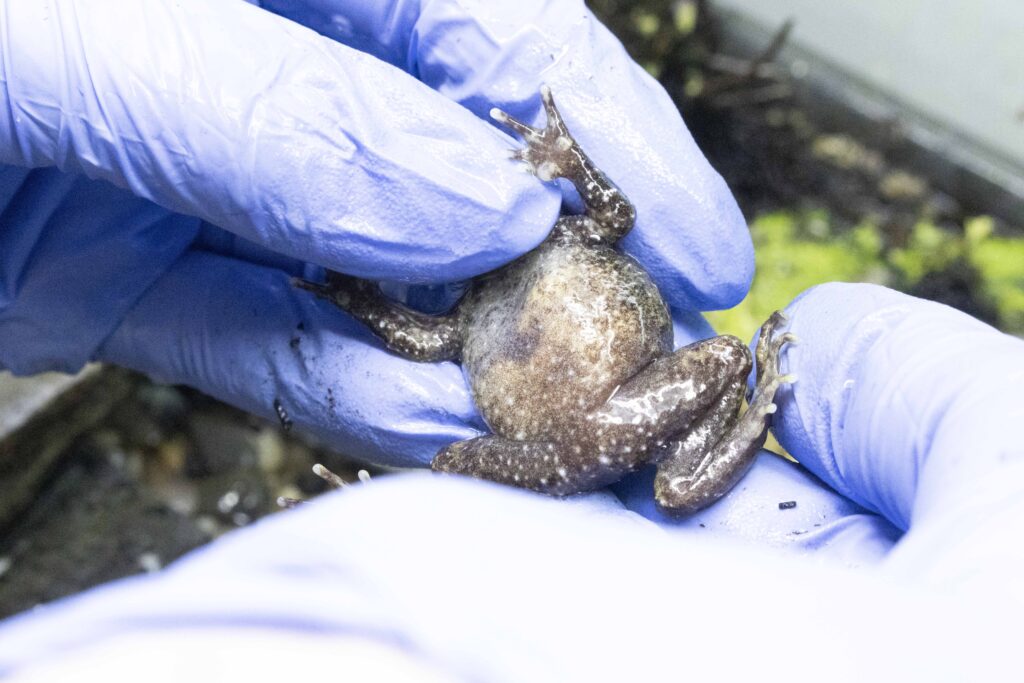
Image by ©Oscar Thomas
Disease management
The Department of Conservation and frog researchers work hard to reduce the threat of infection by chytrid fungus. Strict biosecurity rules aim to prevent the spread of chytrid fungus and frog populations are regularly monitored for infection. All people visiting areas with frog populations adhere to strict hygiene protocols including not taking packs, bags or gaiters into frog areas, and treating clothing, footwear and research equipment with a biocide known to kill the fungus.
Control of predators
The Department of Conservation runs a predator control programme to protect the Archey’s frog population at Whareorino incorporating both aerial and ground based rat control. Archey’s frog populations within the treatment area are increasing; adult frogs show increased survival and breeding success. Other populations benefit from landscape scale predator control aimed at other species, often birds. Hochstetter’s populations in the predator-free ecosanctuary at Maungatautari are recovering rapidly.

Image by ©Oscar Thomas
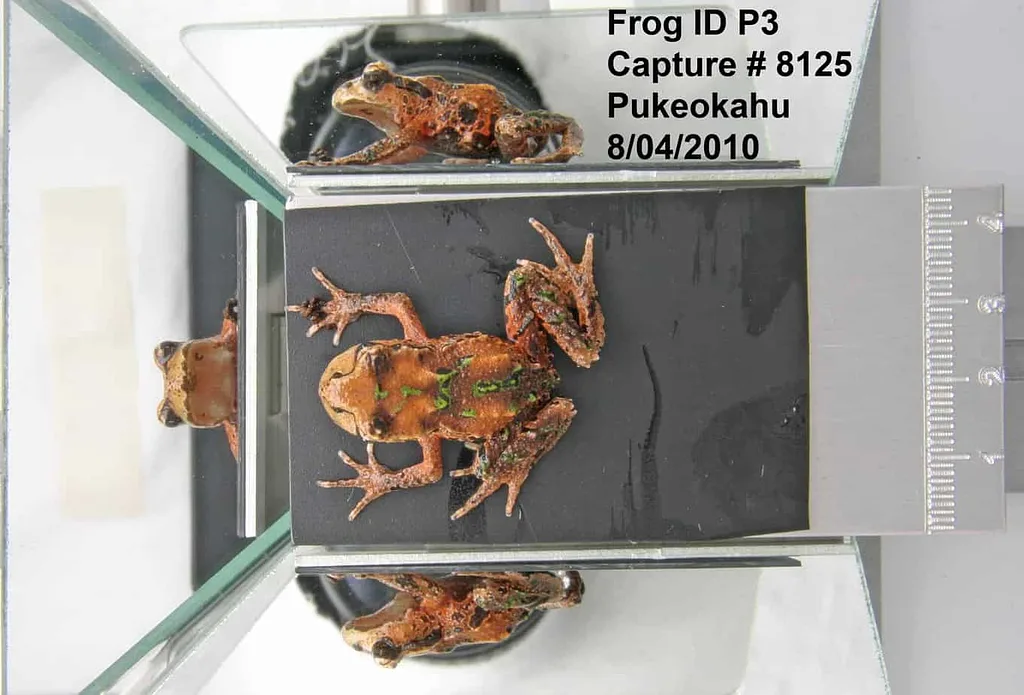
Image by Department of Conservation
Population monitoring
Across New Zealand ‘capture-recapture’ studies allow conservationists and scientists to understand trends in native frog populations and their response to conservation interventions including translocation and pest control. Dr Ben Bell and his colleagues from the University of Victoria started long-term population monitoring for Hamilton’s frog on Maud Island in 1976 and Archey’s frog in the Coromandel in 1982. These ongoing studies have revealed important insights into population trends and the life cycles of our native frogs. Native frogs can take up to 7 years to reach breeding maturity and live up to 45 years!
Holly the Frog Dog
Holly has been trained to detect native frogs to aid in their conservation. She is a Nova Scotia Duck Tolling Retriever specialising in sniffing out New Zealand native frogs. She started her frog detection training in 2019 and is only one of a few dogs in the entire world to learn how to find frogs by scent! The other frog dogs work overseas as a part of the Amphibian Research K9 team in the United States and at Zoos Victoria in Melbourne. Holly has her own page here where you can learn more about her and what she is up to.
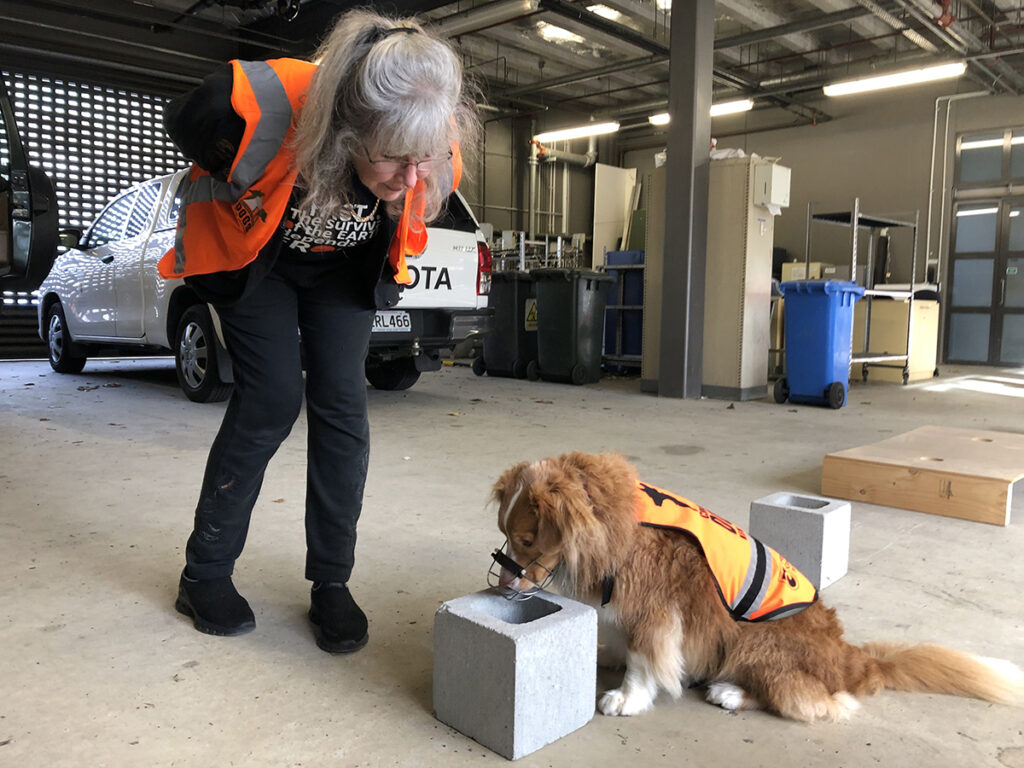
Image supplied by UoO Guy Fredrick
How you can help with the conservation of New Zealand native frogs
If you find a frog that fits the description of a native frog (head to our resources page for identification guides), it is important that you do not capture or handle the frog. Take a photograph or make notes about its appearance, its habitat and location. Report your findings to the nearest office of the Department of Conservation as soon as possible or send in a report to NZFrogs. You can contact the NZFrogs team using enquiries@nzfrogs.org
You can also donate to help fund frog conservation projects by clicking the green donate button
Remember, all native frogs are protected by the New Zealand Wildlife Management Act. This means it is illegal to collect any native frog from the wild without a permit from the Department of Conservation (see Frogs and the Law on our resources page).
Global Amphibian Decline
The issue of declining frog populations was first highlighted in 1989 when a group of over 1400 from 60 countries throughout the world, descended upon the town of Canterbury in the UK for the First World Congress of Herpetology. It was at this meeting that a disturbing number of researchers reported apparent declines in their study populations and of growing concern were the reports of declining populations from seemingly pristine habitats. We are now nearly 40 years down the line, with over 250 publications being produced relating to global amphibian declines and as yet we are not much further ahead in identifying the cause. Throughout the World over 200 amphibian species have experienced recent population declines, with reports of at least 32 species extinctions.
The possible causes of amphibian declines can be grouped into seven broad categories. Habitat Destruction, Pollution, Climate Change, UV Radiation, Predators and Disease, Over Exploitation and The Pet Trade. All of which are interrelated and it is likely a complex web of stresses may be causing the demise of many populations.
FUN FACT: the metaphor that frogs are like canaries in a coal mine is often used to highlight that amphibians can be helpful bioindicators to understand the health of an ecosystem!

References
Bell, B. D., Pledger, S., & Dewhurst, P. L. (2004). The fate of a population of the endemic frog Leiopelma pakeka (Anura: Leiopelmatidae) translocated to restored habitat on Maud Island, New Zealand. New Zealand Journal of Zoology, 31(2), 123-131.
Bell, B. D., Carver, S., Mitchell, N. J., & Pledger, S. (2004). The recent decline of a New Zealand endemic: how and why did populations of Archey’s frog Leiopelma archeyi crash over 1996–2001?. Biological Conservation, 120(2), 189-199.
Bell, B. D., & Pledger, S. A. (2010). How has the remnant population of the threatened frog Leiopelma pakeka (Anura: Leiopelmatidae) fared on Maud Island, New Zealand, over the past 25 years?. Austral Ecology, 35(3), 241-256.
Bell, B. D., & Pledger, S. A. (2023). Post-metamorphic body growth and remarkable longevity in Archey’s frog and Hamilton’s frog in New Zealand. New Zealand Journal of Ecology, 47(2).
Bishop, P. J., Angulo, A., Lewis, J. P., Moore, R. D., Rabb, G. B., & Moreno, J. G. (2012). The Amphibian Extinction Crisis-what will it take to put the action into the Amphibian Conservation Action Plan?. SAPIENS. Surveys and Perspectives Integrating Environment and Society, (5.2).
Bishop, P. J., Daglish, L. A., Haigh, A., Marshall, L. J., Tocher, M., & McKenzie, K. L. (2013). Native frog (Leiopelma spp.) recovery plan, 2013-2018. Wellington: Publishing Team, Department of Conservation.
Eda, A. R. A. R., Bishop, P. J., Altobelli, J. T., Godfrey, S. S., & Stanton, J. (2023). Screening for Batrachochytrium dendrobatidis in New Zealand native frogs: 20 years on. New Zealand Journal of Ecology, 47(2), 1-10.
Egeter, B., Robertson, B. C., & Bishop, P. J. (2015). A synthesis of direct evidence of predation on amphibians in New Zealand, in the context of global invasion biology. Herpetological Review, 46(4), 512-519.
Germano, J. M., Bridgman, L., Thygesen, H., & Haigh, A. (2023). Age dependent effects of rat control on Archey’s frog (Leiopelma archeyi) at Whareorino, New Zealand. New Zealand Journal of Ecology, 47(2), A3.
Hotham, E. R., Muchna, K., & Armstrong, D. P. (2023). Abundance of Leiopelma archeyi on the Coromandel Peninsula in relation to habitat characteristics and land-use. New Zealand Journal of Ecology, 47(2), 1-11.
Longson, C. G., Brejaart, R., Baber, M. J., & Babbitt, K. J. (2017). Rapid recovery of a population of the cryptic and evolutionarily distinct Hochstetter’s Frog, Leiopelma hochstetteri, in a pest‐free environment. Ecological Management & Restoration, 18(1), 26-31.
Luedtke, J. A., Chanson, J., Neam, K., Hobin, L., Maciel, A. O., Catenazzi, A., … & Stuart, S. N. (2023). Ongoing declines for the world’s amphibians in the face of emerging threats. Nature, 1-7.
Melzer, S., & Bishop, P. J. (2010). Skin peptide defences of New Zealand frogs against chytridiomycosis. Animal Conservation, 13, 44-52.
Ohmer, M. E., Herbert, S. M., Speare, R., & Bishop, P. J. (2013). Experimental exposure indicates the amphibian chytrid pathogen poses low risk to New Zealand’s threatened endemic frogs. Animal Conservation, 16(4), 422-429.
Towns, D. R., & Daugherty, C. H. (1994). Patterns of range contractions and extinctions in the New Zealand herpetofauna following human colonisation. New Zealand journal of zoology, 21(4), 325-339.
Worthy, T. H. (1987). Palaeoecological information concerning members of the frog genus Leiopelma: Leiopelmatidae in New Zealand. Journal of the Royal Society of New Zealand, 17(4), 409-420.
Wren, S., Bishop, P. J., Beauchamp, A. J., Bell, B. D., Bell, E., Cisternas, J., … & Germano, J. M. (2023). A review of New Zealand native frog translocations: lessons learned and future priorities. New Zealand Journal of Ecology, 47(2), A12.
